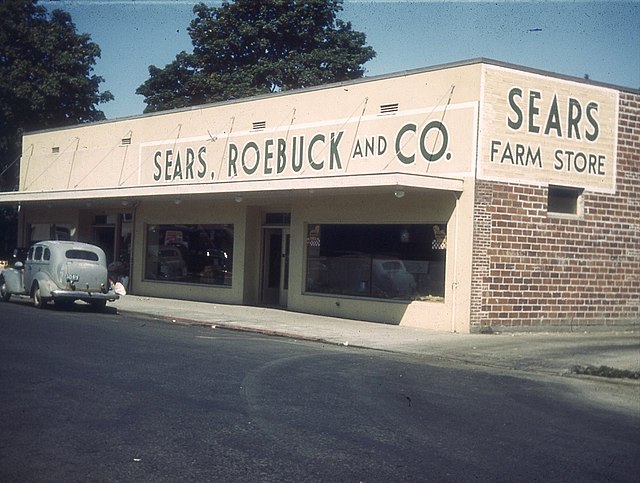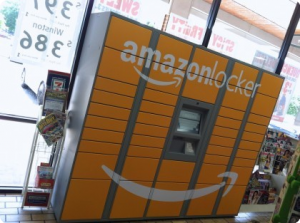How the History of Mail Order Can Help Us Manage Innovation at Scale

GUEST POST from John Bessant
2022 was a record year for home delivery of parcels and packages. After the Covid-19 lockdowns the idea of remote shopping became an even bigger reality and changed the behavior patterns of millions. It’s a habit which is hard to break — even when there are increasing disturbances in the delivery end of things like strikes and negative publicity surrounding how packages are actually handled and delivered. Estimates of the market size for this activity vary widely but suggest that it is worth close to $500bn worldwide.
But where did this revolution begin and what’s the innovation history behind remote retailing? For that we need to go back a couple of hundred years and locate ourselves in the beautiful hills of Powys in Wales. In the valley alongside the river Severn is the small town of Newtown, a market center since the 13th century. And in 1856 the home of Pryce Jones, a draper’s assistant who rose to take over the business in which he worked. And for which he had big plans.
He renamed the company the Royal Welsh Warehouse and specialized in selling Welsh flannel. His vision grew out of a belief in the wonderful powers of the soft warm fabric crafted from wool from the sheep he could see on the hillsides all around him. But it was also sharply focused on the potential size of that market — if he could only grow it. Which he did courtesy of two key enabling innovations which reached sufficient maturity to give him the channels to reach his imagined global market.
The channels were the postal system and the railways. Neither was new by this time but they were now coming of age — and enabling hitherto unrealizable dreams to take shape. Back in 1654 Oliver Cromwell had established the idea of a state postal system but it was another 30 years before a reliable system began to operate around the city of London. And another hundred years before Parliament authorized the creation of ‘Penny Posts’ in any town or city; while the idea grew in popularity it was still expensive and local in impact. It wasn’t until the major reforms of the Post Office in 1840 that the idea of a Uniform Penny Post was established, facilitating the safe, speedy and cheap conveyance of letters. With it came the first pre-payment in the form of postage stamps (beginning with the famous Penny Black).
Pryce Jones was quick to spot the possibilities in the newly-emerging postal system and began offering his wares via mail order. The offer was simple; place your order via mail and it will be delivered the next day (effectively anticipating Amazon’s Prime service by 150 years and offering faster delivery!). To explain to his market what he had to offer he developed an illustrated catalogue from which they could choose what they wanted; he launched this in 1861.
He was able to fulfil this delivery promise because the railways had also come of age; from the ‘Rocket’ which George Stephenson demonstrated in 1829 the idea of modern railway network had developed rapidly. The railway came to Newtown and Jones was quick to exploit its possibilities, building a warehouse next to the station and opening his mail order business alongside the post office. He expanded several times and in 1879, he built the Royal Welsh Warehouse, a tall red brick building in the centre of Newtown which still stands today.
His idea paid off; within months his business had started to grow and by the 1880s he had an international operation, counting amongst his patrons included the royal houses of Austria, Britain, Denmark, Germany, Hanover, Italy, Naples, and Russia. Valuable customers not only for their purchases but also for their implicit endorsement. Because Jones wasn’t just skilled at utilising new channels; he also played the role of ‘conveyor’, someone actively encouraging and promoting the use of the new business model along these channels. His mail order catalogue wasn’t simply a price list of items, it was a form of storytelling, complete with pictures and expansive descriptions. He understood the principles of marketing, the need to get consumers to buy into a vision of something which they wanted — and then he was able to fulfil that demand.
(He was also a gifted product innovator; amongst other things he is credited with the invention of the sleeping bag which he patented in 1876 under the name of the Euklisia Rug. He exported the product around the world, at one point landing a contract with the Russian Army for 60,000 rugs.)
Pryce Jones wasn’t alone; like so many innovations the idea of mail order retailing came to several people independently and around the same time, reflecting the changing environment and the enabling technologies. For example in Austria the Thonet family began selling their furniture in 1859 using a mail order catalogue and taking advantage of postal and transport innovations. In fact Pryce Jones’ model was predated by the US luxury goods company Tiffany’s who in 1845 launched their ‘Blue Book’ — arguably the world’s first mail order catalogue though targeted at a very small, select (and wealthy) market.
It wasn’t long before other entrepreneurs began to see the possibilities beyond extending the reach into new markets for particular products. They realised that there was a second side to the new market-place — the suppliers. These days we’re used to seeing examples of ‘platform’ businesses everywhere we look — just glance at your smart-phone to see the array of apps (representing goods and services) being offered across the platform of its shiny screen. But it was 150 years ago that this kind of business model first emerged.
In 1872, Aaron Montgomery Ward from Chicago started his own single-page mail order catalogue; it listed 163 items for sale. He’s credited amongst other things with coining the sales slogan ‘satisfaction guaranteed or your money back!’ The model worked; ten years later the ‘Wish book’ catalogue listed over 10,000 items. Most important was the fact that Ward didn’t manufacture many of these; he effectively created the platform across which the market in multiple goods and services could operate.
In doing so he paved the way for many others spotting and exploiting a similar opportunity. For example in Canada one of the largest department stores was the Eaton Company originally founded in 1869 to sell dry goods, backed by a growing network of factories.

Timothy Eaton saw the possibilities in mail order and in 1884 released its 32 page catalogue. He expressed his vision of a network stretching across the sub-continent of Canada in a note accompany the catalogue; “This catalogue is destined to go wherever the maple leaf grows, throughout the vast Dominion. We have the facilities for filling mail orders satisfactorily, no matter how far the letter has to come and the goods have to go.”
And down in North Redwood, Minnesota Richard Warren Sears , a railroad services agent. began a sideline business by purchasing a batch of watches which had been refused delivery and selling them on to local people. In 1886, he used the profits he earned from it to set up a mail-order business selling watches as R.W. Sears Watch Company. That year he met a watch repairman named Alvah Curtis Roebuck and in 1887 the two of them relocated their business to Chicago. In 1888 they launched a printed catalogue offering a range of luxury goods like watches and jewelry; by 1892 this had grown to a 322 page catalogue which included sewing machines, sporting goods, musical instruments, saddles, firearms, buggies, bicycles, baby carriages, and some clothing.

What Sears and Roebuck (and a growing number of others) were doing was developing the new business model of a platform, using the catalogue as the focal point across which remote retailing could expand. But this wasn’t simply a matter of printing and distributing a catalogue; what they were doing was mastering the art of building an ecosystem for retail innovation. They recognized that simply advertising a wide range of products and services to an expectant public would be a very fast way of losing money and reputation. In order to make the system work they needed to pull together a network and get it working to deliver ‘emergent properties’ — where the whole offered more than the sum of the parts.
Making remote retailing work meant finding ways to procure (or manufacture) a wide range of products and then holding them in a warehouse so they are available for quick delivery. But holding stock takes up space and costs money so the trick is to manage the logistics of sales forecasting, order processing and stockholding, plus being able to ensure rapid and reliable delivery. Which places emphasis on reliable channels — as Pryce Jones discovered.
And underneath this web of suppliers and deliverers is the challenge of cash flow — how to ensure enough money comes back into the system fast enough to cover costs and return a profit which helps keep the supply side engaged. New models for financing and payment began to emerge — not least the concept of paying cash on delivery.
The model expanded throughout the world and was often at the heart of a move from remote shopping to direct retail. The origins of the 20th century department store include a sizeable crossover — for example Kastner & Öhler was the first mail order business in Central Europe. The company was founded in 1873 in Austria, releasing its first mail order catalogue in 1885; as it grew it opened its first department store in 1894 and went on the become one of the household names in European retailing.
Mail order was a powerful business model which worked well during most ot the 20th century — but as we’ve learned so often about innovation, nothing lasts forever. New developments opened up new possibilities and it is not always the existing players who are best placed or able to exploit them. In the early 1980s a new channel began to appear — the internet. It opened up not only new opportunities in terms of potential reach, mirroring what Pryce Jones had seen in the emergence of uniform postal systems a century before. But it also changed the underlying thinking behind some of the core warehousing and logistics underpinning the mail order model.
Jeff Bezos was aware of the opportunity and had created a list of possible sectors to target with an internet-based model. He chose books, and quickly realized that he could not only reach a huge market via this new channel but he could also service it without the high costs of actually warehousing and distributing the books. He recognized the ‘long tail’ possibilities; with his model he could reach people with highly specific needs and connect them to suppliers who could meet that need. He also saw that the underlying business model was available to anyone — the advantages would come to those who could scale early and build a platform. As the major bookseller Barnes and Noble pointed out in their submission to legal authorities in their lawsuit of 1997Amazon was not a bookseller at all, it was a book broker.
Where Amazon and others paved the way for a new model to emerge, putting the platform kind of business on steroids, others were slower to recognise and adapt. The German firm Quelle had grown since its founding in 1927 to become one of the biggest mail order operations in Europe, with a dedicated logistics and warehousing operation near the town of Fürth in Bavaria. It was, along with Tempelhof airport in Berlin, one of the largest industrial sites in Europe stretching over nearly 7 hectares. But a failure to adapt fast enough to the rapid changes being brought about through internet retailing meant that by 2006 it collapsed into bankruptcy. All that remains today is the 90m high Quelle-Turm (Quelle Tower) built in 1964 and now preserved as a landmark to a different industrial era.
One of the features of the model Pryce Jones developed was the stimulus it gave to local producers, enabling the region around Newtown to prosper with new businesses. And something very similar has happened with the internet-driven mail order business built across the huge Alibaba platform in China. In 2003 Jack Ma launched the idea of a Taobao marketplace where people could trade goods and services using the ability of the platform to reach a large and distributed market and display content in rich and interesting formats.
This model is comprised primarily of small businesses but has grown to be the largest digital retail platform in the country and has spawned many ‘Taobao villages’ — areas where over 10% of the population is engaged in online retailing. It has had a huge impact on the rural economy; by August 2019 there were nearly 4500 Taobao villages in 25 provinces and estimates suggest up to half of the rural population has benefitted from this. It is equivalent to around 600,000 small shops and trading businesses employing around 10 million people with an economic value of around $195 billion worth of e-commerce sales.
The story is of course not over. With the rising expectations of a growing market for instant delivery has come a challenge and opportunity around the ‘last mile’ challenge — how to move from the digital world to physical delivery of products. And whilst there are many major traditional logistics players now operating in this space there are challenges on the horizon — for example drone delivery or even 3-D printing of a growing range of physical products. The virtualisation process has only just begun though it may still be a while before the Welsh flannel beloved of Pryce Jones emerges spinning out of a 3-D wool printer in our homes.
But perhaps the best kept secret is the one shrouded in Arctic mists and dating back hundreds of years. Somehow a single enterprise (the mysterious S. Claus operation) has managed the challenge of reliable overnight delivery on a global basis to millions of expectant children; there are clearly lessons still to be learned around wish fulfilment innovation.
You can also hear this as a podcast or watch it as a video.
If you’d like more songs, stories and other resources on the innovation theme, check out my website or listen to my podcast. And if you’d like to learn with me take a look at my online course here
Image credit: Wikimedia Commons, Unsplash
![]() Sign up here to get Human-Centered Change & Innovation Weekly delivered to your inbox every week.
Sign up here to get Human-Centered Change & Innovation Weekly delivered to your inbox every week.
 FedEx took the shipping world by storm about forty years ago, growing to become the defacto shipping leader, unseating UPS and DHL. But, then after thirty years of strong growth they began to lose their mojo. In 2003, in a reaction to UPS’ acquisition of Mail Boxes Etc., FedEx announced they were buying Kinko’s, a large United States based copy center chain. For me this showed that FedEx was beginning to lose its way, and it appears their connection to customer expectations and the current capabilities of technology is failing. For a company based on the promise of speed, FedEx is becoming increasingly slow.
FedEx took the shipping world by storm about forty years ago, growing to become the defacto shipping leader, unseating UPS and DHL. But, then after thirty years of strong growth they began to lose their mojo. In 2003, in a reaction to UPS’ acquisition of Mail Boxes Etc., FedEx announced they were buying Kinko’s, a large United States based copy center chain. For me this showed that FedEx was beginning to lose its way, and it appears their connection to customer expectations and the current capabilities of technology is failing. For a company based on the promise of speed, FedEx is becoming increasingly slow.
 I came across a
I came across a  So who should have come up with this potential innovation?
So who should have come up with this potential innovation?